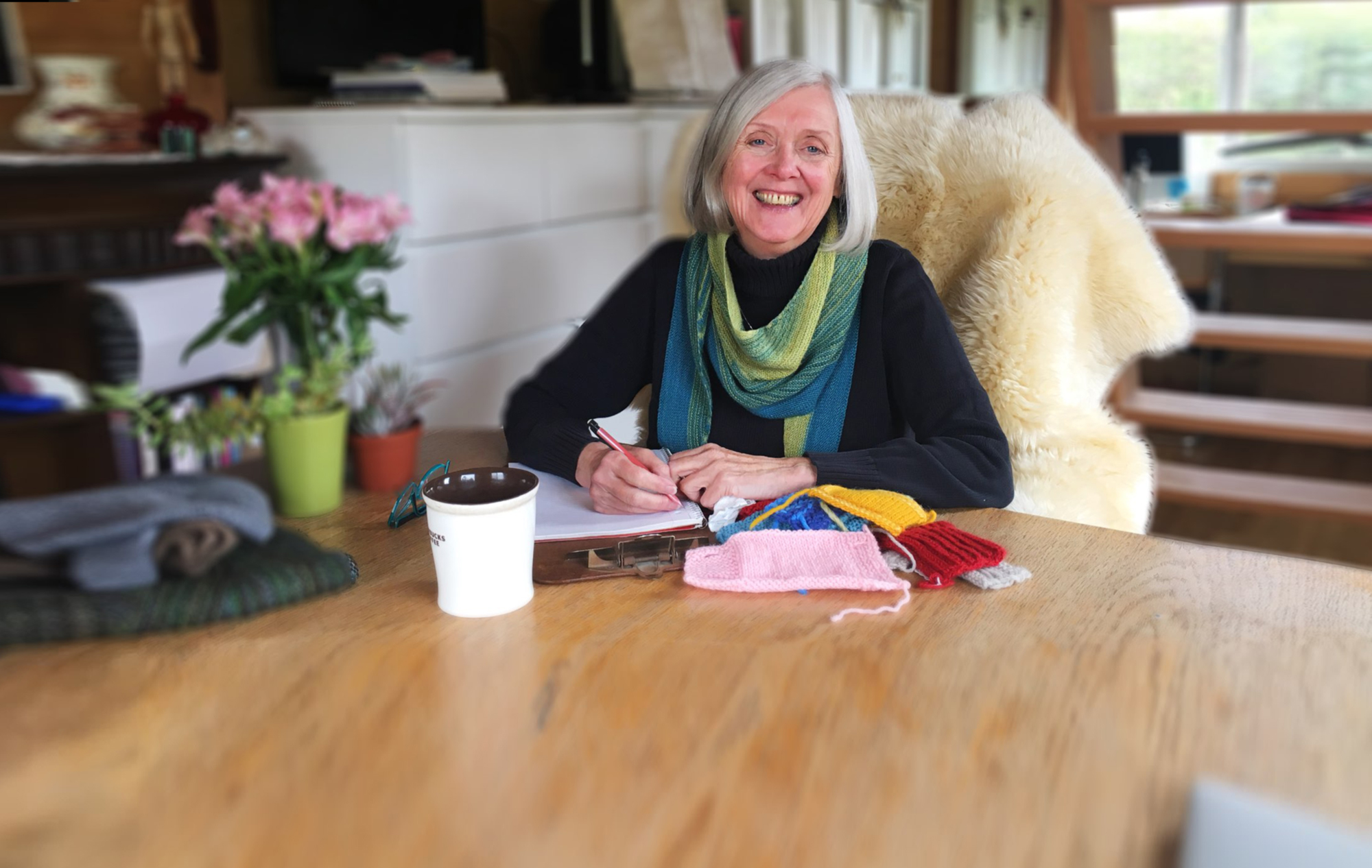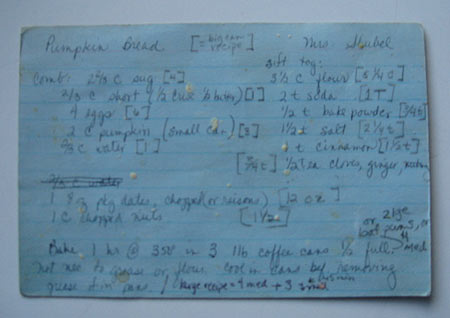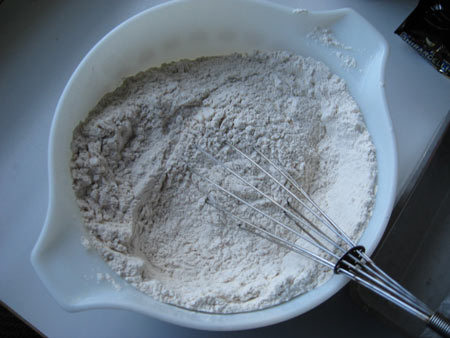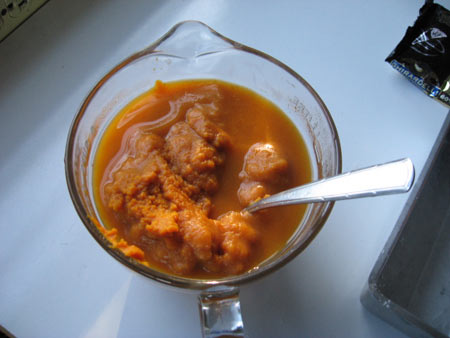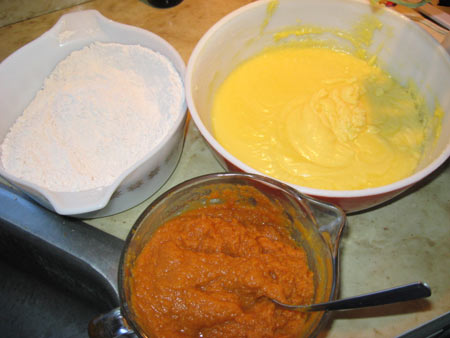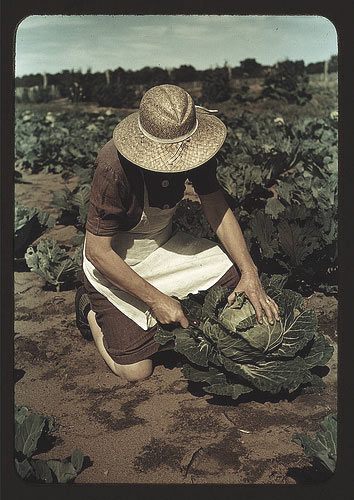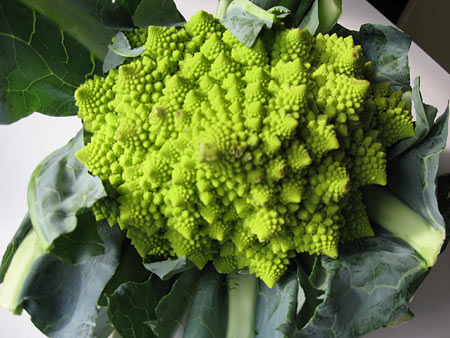Several days ago my son handed me his favorite sweater. There was a hole. He knows to pay attention to such things as soon as they appear but this was near his elbow, he’s a very active fellow, and he didn’t notice it until it had grown . . . well, you see.
Cracks . . . in Ice and a Marriage
Winter of 1976-77. We had one of those Michigan ice storms. You know. The ones that coat tree limbs and electrical lines with 1/2 inch thick or more enclosures of ice. The kind of ice that snaps things off. From weight, from brittleness, just for the gorgeous hell of it.
And it was beautiful. An ice-encrusted tree limb is exquisite in the bitter winter sun. Until one breaks and falls across a wire, the one that delivers you life-giving electricity.
We had “a beautiful home.” Huge by the standards of the time. We could entertain 70-80 people with two dozen pot luck salads and desserts and vats of chili and people didn’t even bump in to one another. It had “good traffic flow” as they say. But when the electricity went out
1) We had no water.
2) We had no heat.
We moved to my mother’s house, some 25 miles south. For a week.
I said, “This makes no sense. A home is supposed to be shelter. And in the worst weather ever, when we need it most, this house gives us no shelter. What good is it if it can’t do that?”
When we moved back a week later, Ma came with us. I can’t remember why.
In the process of checking pipes and everything else I opened the freezer door of the refrigerator and it was full. To the brim. With bread dough that had thawed and expanded to fill the entire compartment. I gasped and laughed and Ma said, “Just punch it down and bake it up.”
I baked 5 loaves of bread that evening. Ma took 2 of them home. And I never felt secure in that house again.
Husband #1 was a very good man. He didn’t share my need to live in a small, simple place that would have heat and water even when the electricity went out. Still, I sometimes regret having left that marriage. And smile when I remember that it happened at all.
Dating Jesus
I once performed in an original Easter Oratorio as Pilate’s wife. I went out on a date with the man who played Jesus. I was very happy to tell this to my mother, a devout Catholic who was worried about my relationship to The Church.
He had the driest kisses of any I have experienced outside those of my brothers. He was a baritone. I had hoped for something lustier. He did, however, have a voice that could make a person swoon.
A simple holiday season and Pumpkin Bread. . .
My “Holidays” are the simplest of any I know. I made that choice 40 or so years ago. It suits me and I want to share what that looks like.
Because I come from a Catholic tradition, my celebration for this time of year is, basically, Christmas. But I resonate with the Solstice, so I celebrate both in quiet ceremonies at home. In the afternoon and evening I gather with family and friends. I adapt to the people around me and my geographical location at the moment, but simplicity is key.
I have one child. I collect things during the year that I think would make his life more wonderful. He is the only person on “my list” so anyone and anything beyond that is optional. Don’t get me wrong. I love giving and getting meaningful gifts . . . but “meaningful” is the operative word here. Everyone I know has more stuff than they want or need. I don’t feel obligated to contribute to their burden of stuff to take care of . . . but if there is something I can give that is thoughtful and heartfelt and needed? . . . I’m all over it, though I usually deliver at any time during the year, when it’s really needed.
I do, however, have one little gift tradition . . . I make Chocolate Chip Pumpkin Bread for selected friends, family and acquaintances. It’s a tradition that started in the early 1970s with my next-door neighbor, Mrs. Shubel.
She was in her 80s and lived to the north of the first house I bought with my first husband.
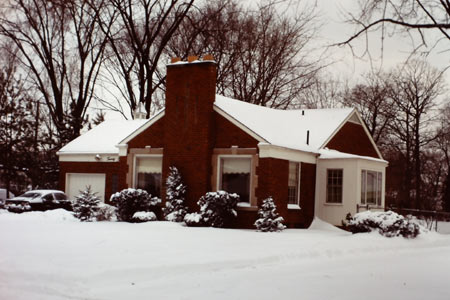
Mrs. Shubel taught me many things, but only two of them were life-changing:
- It’s a worthy thing to have a large, spectacular garden populated with one type of plant that blooms only 3 weeks a year (in her case it was bearded iris).
- It’s important to have a really good Holiday recipe to give as your signature gift.
Mrs. Shubel’s recipe was her Pumpkin Bread. She put dates in it and baked it in one-pound coffee cans. You couldn’t miss it. Who else delivered aromatic cylinders as presents?
But I don’t drink coffee that comes in cans and I’ve had years to play with her recipe. My adaptations settled in about 35 years ago to create my Signature Holiday Gift. I traded chocolate chips for dates and baked it in regular pans. And now I gift it to you. Put your name on it and call it your specialty. Use it to simplify your life . . .
MRS. SHUBEL’S and CHERYL’S HOLIDAY PUMPKIN BREAD waiting for your signature. . .
First . . . it needs to be very cold and beautiful outside . . .
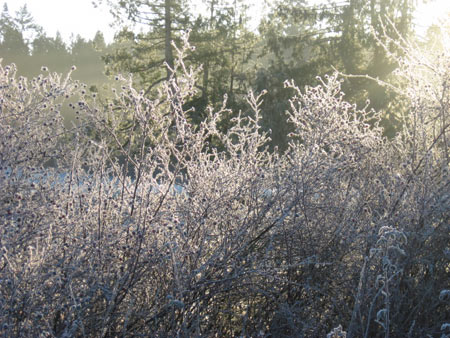
Well . . . that’s not true . . . but this was the view the morning I started baking my 2009 Christmas bread. The winter sun here is rare and thus precious. I enjoy it at any . . . and every . . . opportunity.
Next, read or reread my earlier post about the basics of making any cake (or, in this case, a sweet bread which is the same process): The Zucchinis are Coming . . . Let them be Cake.
The original recipe called for a small can of pumpkin which was about 2 cups at the time. Long ago I upped the recipe so that I could bake more at once and I use the larger can of pumpkin. I will give you both sets of numbers. The numbers in the brackets refer to the more ambitious amount.
DRY INGREDIENTS:
- 3½ C flour [5¼ C]
- 2 t baking soda [1 T]
- ½ t baking powder [¾ t]
- 1½ t salt [2¼ t]
- 1 t cinnamon [1½ t]
- ½ t [¾ t] each of ground cloves, ginger and nutmeg
Put all of these into a bowl
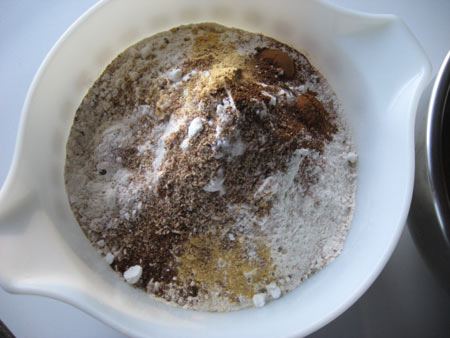 and then gently whisk them together.
and then gently whisk them together.
THE WET INGREDIENTS:
- 2 C pumpkin (small can) [3 C] (most of a large can)
- ⅔ C water [1 C]
Combine these in a separate bowl.
THE CREAM-TOGETHER INGREDIENTS:
- 2 ⅔ C sugar [4 C]
- ⅔ C butter [1 C]
- 4 eggs [6 eggs]
THE CHUNKY ADDITIONS:
- 1 C of chopped dates OR raisins OR chocolate chips [1½ C]
- 1 C of chopped walnuts [1½ C]
Start by beating the “cream-together” ingredients with an electric hand or stand mixer. You could even use a wooden spoon if that’s all you had but it’s a lot of work. Soften the butter first. It sat out at room temperature over night (but the room was pretty chilly).
Notice how it gets lighter in color as you incorporate air.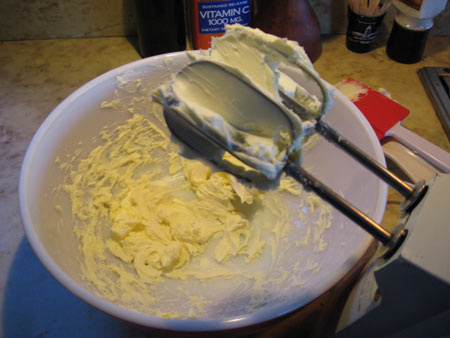
Once it’s fluffy start adding the sugar about a cup at a time.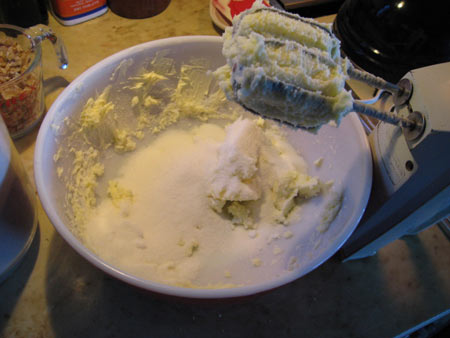 and beat after each addition to incorporate the sugar evenly.
and beat after each addition to incorporate the sugar evenly.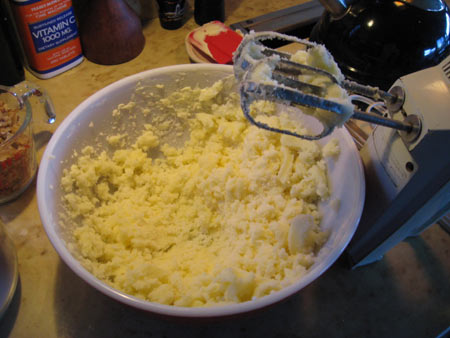
Once the sugar is all in you can add the eggs, 2 at a time, and beat after each addition: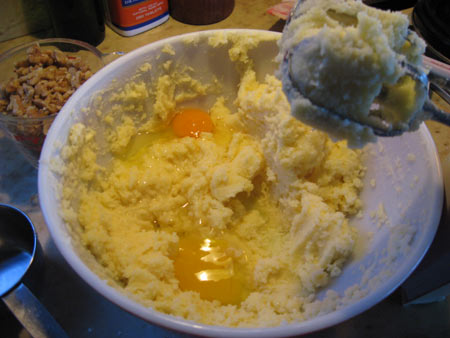 (Notice the bright orange yoke versus the lighter yellow yolk of the larger egg in front. The bright orange yolk is from my friend’s chicken, the lighter one is store-bought.)
(Notice the bright orange yoke versus the lighter yellow yolk of the larger egg in front. The bright orange yolk is from my friend’s chicken, the lighter one is store-bought.)
And now you have 3 bowls of ingredients: dry, wet and creamed.
Some important notes here.
- Once you combine the baking soda and powder with liquid, you’re starting the chemical reaction that makes bubbles so you need to get it into a preheated oven (350º) in a hurry. That means your pans should already be prepared.
- When you were working with the butter, sugar and eggs, you beat the heck out of it to incorporate air. Now, you are going to stir gently . . . just enough to mix everything evenly. If you beat it, it will develop the gluten in the flour and it will be tough. That’s why we knead bread . . . to give it that chewy texture. However, you want your cakes and sweet breads to be tender and a little crumbly.
Let me back up a little here. My actual order of doing things is this:
- The night before baking I assemble the dry ingredients and take the butter and eggs out of the refrigerator and let them come to room temperature overnight.
- At baking time, before I start the mixing process I prepare the pans and turn on the oven.
THE BAKING PANS
Mrs. Shubel’s original recipe calls for 3 one-pound coffee cans half filled and baked at 350º for one hour. These are my adaptations:
Smaller recipe: 2 standard loaf pans (9″ x 5″ x 2¾”) OR 4 medium loaf pans (7½” x 3¾” x 2¼”) OR one standard pan and 2 mediums.
Larger recipe: This is how I usually do it. I use my 4 medium pans plus 3 smaller ones (5½” x 3″ x 2″).
I’m trying to make this simple and I realize that not everyone has 4 sizes of loaf pans on hand, but this is the best I can do with honesty. If you are a novice baker and you like things like zucchini, pumpkin and banana bread, you need 2 standard loaf pans. That’s how I started. These kinds of breads freeze very well and it takes just as much effort to make one loaf as two, so make at least 2 at a time.
Regardless of the size of the pans, this is how you prepare them.
- Grease them with Crisco or butter. That means to take a piece of paper towel or waxed paper, grab a small clump of solid fat with it and rub all the interior surfaces of the pans.
- Cut pieces of waxed paper (or baking parchment) the size of the bottoms of the pans.
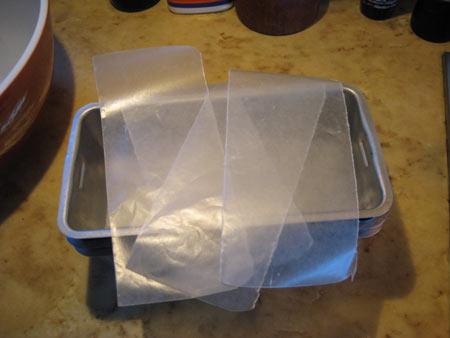
- Once the pans are greased the paper clings easily to them.
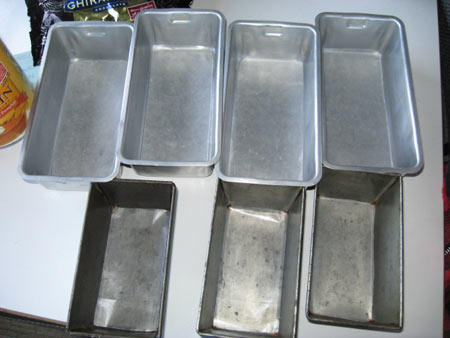 4. How long you bake them depends on the size of your pans and your oven but I find that these pans need about 45 minutes of baking. You might need to take the smaller ones out of the oven earlier. Just keep testing by inserting a toothpick into the center of the loaf. If it comes out clean and not with goopy batter on it, they’re done.
4. How long you bake them depends on the size of your pans and your oven but I find that these pans need about 45 minutes of baking. You might need to take the smaller ones out of the oven earlier. Just keep testing by inserting a toothpick into the center of the loaf. If it comes out clean and not with goopy batter on it, they’re done.
Lactose intolerance
Sexy title for a blog post, no?
In 1971 I taught at the Seoul American Middle School on the military base in Seoul, Korea. It was during the Viet Nam war. My students were, as a group, the most physically beautiful humans I’ve ever been among, mostly because many of them were ethnically mixed. A large number were Korean-American. Their mothers were Korean, their fathers American, most Caucasian, some African-American.
Many of their fathers were in Viet Nam and the children stayed in Seoul, living with and in their Korean families. And this caused a problem in the classroom.
My students who were of European descent complained that the Korean-American students smelled of garlic. My Korean-American students complained that those of European descent smelled like sour milk.
We talked about it and decided, in a respectful way, that they could sit on opposite sides of the room, but there was to be no name-calling or complaints and when we did a project that involved mingling, they would simply have to deal with it.
Just this morning I ran across this in a report from the Food Empowerment Project:
“According to the U. S. Department of Health and Human Services, ‘The pattern of primary lactose intolerance appears to have a genetic component, and specific populations show high levels of intolerance, including approximately: 95 percent of Asians, 60 percent to 80 percent of African Americans and Ashkenazi Jews, 80 percent to 100 percent of American Indians, and 50 percent to 80 percent of Hispanics. Lactose intolerance is least common among people of northern European origin, who have a lactose intolerance prevalence of only about 2 percent.'”
Even though I have northern European background, I haven’t drunk cow’s milk in years. I don’t particularly like it and ever since the advent of rBST, I’m careful to choose dairy products from animals that haven’t been treated with it.
There is a lot of energy going into improving the food we feed to our children at schools. Milk is a major staple of the National School Lunch program. Here we have an opportunity to change public policy based on research. What a novel idea!
Saying grace before meals. . .

I grew up in a Midwest Catholic household. Dad was from French-Canadian stock. He seldom went to church but his sisters were zealots. They frowned a lot. Ma was devout but not as strict as her sisters-in-law. She went to Mass every Sunday, made hundreds of rosaries “for the missions” out of nickel wire and plastic beads and made her children go to church and catechism every week. Also . . . no meat on Friday, not even for Dad, who laughed a lot.
I spent much of my childhood worrying that Daddy would go to Hell for not going to Mass on Sundays. In the 1950s, this was a “mortal sin.” Ma explained it away by saying he had “a heart condition,” which he did, but even as a kid I wasn’t buying that excuse. He could go to work. That meant he should go to Mass according to Sister Mary Joseph. But Dad was a generous man. The priest would come to our house to have a drink and solicit a pledge for some drive or another. Dad would write a check. I believe these contributions gave him an exemption from eternal damnation.
I left the Church when I left home to go to college mostly because I thought it was sexist and I found the doctrine contradictory. That and I was adamant that I was going to use birth control until I wanted a child.
I am, however, grateful for having been raised Catholic. There was beauty and drama and ceremony and ritual that served my soul. The archaic Latin . . . candles . . . incense . . . changing the priests’ vestment colors with the seasons . . . Midnight Mass on Christmas Eve. I still value ritual and a sense of reverence.
One of our rituals at home was saying grace before meals: “Bless us Oh Lord, and these Thy gifts, which we are about to receive from Thy bounty through Christ, Our Lord, Amen.” It rolled out of our mouths like a single word.
My current favorite grace was introduced to me by Beloved Son several years ago. Whenever he and I eat together, we say it and I try to say it as often as I remember. It is from Thich Nhat Hanh.
This food is the gift of the whole universe, the earth, the sky, and much hard work.
May we live in a way that makes us worthy to receive it. May we transform our unskillful states of mind, especially our greed, our judgmentalness, our fears, our aggression, and our defensiveness. May we take only foods that nourish us and prevent illness. We accept this food so that we may realize the path of love and compassion.
I’m not “religious,” but I am connected to Spirit every day. Water and food, our most essential elements of survival, are gifts. I like to say thank you for them. I don’t remember to do it all the time. But when I do . . . my world feels clear and grounded.
Beauty is Food, Food Beauty (with apologies to Keats)
There is a story told about Albert Einstein. He was asked by a reporter something to the effect of, “What do you think is the most important question facing us today? “His answer was close to this: ‘The most important question a person can ask is, ‘Is the Universe a friendly place?'”
My answer is yes, this is a benevolent universe . . . and here’s a piece of evidence to support that choice:
Romanesco. It’s a broccoli/cauliflower of sorts. I think I’ll roast it . . . probably over 3 or 4 days as it’s quite large. But for now . . . I’m just going to admire it.
Too Many Choices
In 1977 my favorite grocery store in the Detroit suburb where I lived was remodeled. It morphed from a regular, human-sized environment into an airplane hangar. It was big enough for weather patterns to form inside.
The first time I went in I skirted the outside edge. I felt safe among the mountains of vegetables and fruits, meats and poultry, eggs and dairy because I could visually ID them. But my downfall came as I detoured into the interior to get a box of cereal. I went tharn. That’s what happened to the bunnies in Watership Down when they were overwhelmed. It’s the lapine equivalent to a deer being caught in the headlights.
I mean, really . . . have you looked at the number of different kinds of cereal there are? I can’t speak for the 21st century, of course, because I rarely venture into the interior aisles of a grocery store and never to the cereal aisle, but there were too many then and I’m guessing that there are more now.
I never went back to that store. I found a bakery, green grocer, wine store and a butcher, and they filled all my needs. It sounds like it would take a lot longer to shop at four stores instead of one but it didn’t. In fact it was faster because I didn’t have to ponder the choices . . . the thousands of choices.
I turns out, I’m not the only one who thinks that too much choice is too much despite our cultural belief to the contrary. There’s a guy who wrote a book about it. He gives a compelling TED presentation here: Barry Schwartz talks about The Paradox of Choice.
